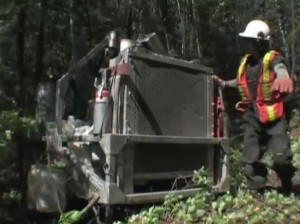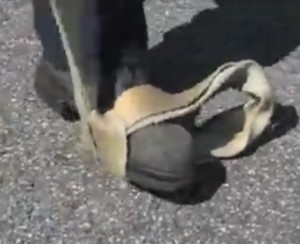Keep Your Eyes on the Hook! Underslung External Load (HESLO) Safety
This video was commissioned by Transport Canada and highlights key lessons for working safely around helicopters and longline loads. 
Video: https://www.youtube.com/watch?v=eESeTQVjOTY
Canadian Coast Guard Ground Crewman Michel Raymond’s story of an incident he was involved in is particular worth hearing.  UPDATE 7 September 2016: A worker got caught in Australia during a helirig operation for a mining company (ATSB database entry and WA Department of Mines and Petroleum report).
UPDATE 7 September 2016: A worker got caught in Australia during a helirig operation for a mining company (ATSB database entry and WA Department of Mines and Petroleum report).
As the helicopter lifted the rig, [a worker’s] leg became entangled in a tag line. He was lifted some distance before the helicopter pilot became aware of the situation.
 The worker fell 5 to 10 metres to the ground, injuring his back.
The worker fell 5 to 10 metres to the ground, injuring his back.
UPDATE 25 November 2016: The Australian Transport Safety Bureau (ATSB) have issued their report:
On 23 May 2016 at about 0700 Western Standard Time, a team of ground and flight crew commenced sling operations to move a drill rig and associated platform and equipment by helicopter to a new location on a salt lake at Lake Disappointment, Western Australia.
The ground team for the removal of the equipment consisted of a load master and a driller’s offsider. The driller’s offsider involved in the operation was new to the role. For the operation, the offisider’s role included ground support and to sling equipment under the guidance of the load master. The load master was to guide the helicopter using hand signals and a two way radio to communicate with the helicopter pilot.
The pilot of an Aerospatiale Industries [sic] AS350 helicopter, registered VH-BII, worked with the ground crew to move three mats and a power pack to a new site, before returning to move the rig.
The load master and offsider attached the rig to the hook under the helicopter and attached two tag lines – 6 m loop slings, to the load on separate corners. At about 1040, in readiness to lift the rig, the load master advised the pilot using hand signals that the load was attached and that they were clear and ready for the lift. The helicopter climbed and the rig lifted a few centimetres above the ground.
The load swivelled as it lifted off the ground, and pushed against a PVC pipe protruding from a bore hole. The load master and offsider stepped in closer to manoeuvre the rig clear of the pipe. The pilot observed the ground crew then step away from the rig. As they stepped back, the offsider had inadvertently stepped into the loop of the tag line. As the helicopter lifted the rig, the tag line went taught, and the offsider’s leg was ensnared in the loop. The offsider was lifted off the ground by the leg and the helicopter began lifting the load.
The load master radioed the pilot, and advised that the offsider was hanging in the loop. The helicopter was then about 50–60 ft above the salt lake. The pilot turned the helicopter around to return to the pad and descended to about 15–20 ft above the ground. The pilot also slowed the helicopter as much as possible given the load and the tailwind, to a groundspeed of about 25 kt. The offsider then freed their leg and was about to jump off, but the helicopter then started to climb and accelerate. The offsider therefore released the tag line and dropped about 10 m into the mud below. The offsider sustained a serious injury.
Safety Actions
The ground crew operations company has advised the ATSB that they have taken the following safety actions:
- people carrying out slinging operations are to use more appropriate tag lines – 16 mm single strand synthetic rope
- ground crew to undergo Dogging training [“use and care of slings and strapping gear, and load movement and crane operations]
- helicopter pilot to visually confirm the load is not entangled prior to moving off
- job hazard analysis to incorporate the use of tag lines
- safe working procedures to take into account visual confirmation that the load is clear
- promotion of ‘take 5 culture’[“Take 5 culture increases safety awareness by encouraging workers to 5 minutes to assess hazards and implement risk control actions.”] to address hazards as they are identified
- platform scales to weigh rig items have been provided, sling line certification has been conducted and and routine condition inspections have been conducted
- UHF radios have been installed.
The air operator has advised the ATSB that they have taken the following safety actions:
- Enhanced briefing implemented for client ground crew which includes potential of entanglement and preventative measures as well as roles when there are more than one ground crew member.
- A risk profile has been completed for tag line use.
- Clients are provided with a personal protective equipment list for their personnel involved with ground operations.
ATSB Safety Message
This incident highlights the importance of conducting a thorough risk analysis prior to commencing operations. The risk assessment should clearly identify hazards and introduce measures that mitigate any associated risks. In addition, it is important to consider possible emergency scenarios and develop procedures to follow in the event of an abnormal situation developing. Appropriate training is essential for personnel working in complex operations. In addition to individual roles and skills, training should include how team members work together to maintain and improve safety. Part of working together safely involves effective communication and a mutual understanding of phrases and signals.
The Flight Safety Foundation (FSF) run Helicopter External Load Operations for Ground Personnel training.
See: UK CAA‘s CAP 426: Helicopter External Load Operations
Also see our articles:
- What the HEC?! – Human External Cargo
- Helicopter Underslung Load: TV Transmitter
- French Skyscraper: Helicopter Underslung Load
- EC120 Underslung Load Accident 26 September 2013 – Report
- UPDATE 19 December 2016: The Tender Trap
- UPDATE 4 February 2017: Unexpected Load: AS350B3 USL / External Cargo Accident in Norway
- UPDATE 12 November 2017: Unexpected Load: B407 USL / External Cargo Accident in PNG
- UPDATE 21 October 2018: Fallacy of ‘Training Out’ Error: Japanese AS332L1 Dropped Load
- UPDATE 1 December 2018: Helicopter Tail Rotor Strike from Firefighting Bucket
- UPDATE 20 December 2019: Helicopter External Sling Load Operation Occurrences in New Zealand
- UPDATE 28 June 2020: Maintenance Issues in Fire-Fighting S-61A Accident
- UPDATE 7 September 2020: Shocking Accident: Two Workers Electrocuted During HESLO
- UPDATE 31 October 2020: Loss of Control During HESLO Construction Task: BEA Highlight Wellbeing / Personal Readiness
- UPDATE 2 April 2021: Windscreen Rain Refraction: Mountain Mine Site HESLO CFIT
- UPDATE 12 June 2021: HESLO Dynamic Rollover in Alaska
- UPDATE 1 January 2022: Snagged Sling Line Pulled into Main Rotor During HESLO Shutdown
- UPDATE 18 March 2023: HESLO AS350 Fatal Accident Positioning with an Unloaded Long Line
- UPDATE 6 April 2024: Fatal Fall after HESLO Helicopter Hooks Worker
UPDATE 28 May 2019: The New Zealand CAA have published details of an occurrence with an AS350B3 in March 2019:
Ground crew member knocked off vehicle while attempting to control a gravel bucket about to be disconnected from hovering helicopter. End of the working day, pack away at helicopter load site. The incident activity occurred when lifting one of two 80kg gravel buckets from the ground onto the deck of the Toyota Land Cruiser for transport back to base. 1 of 2 ground crew attending intervened to control the bucket grabbing the base tube. The pilot made a split-second decision to lift the bucket clear of the vehicle to avoid damaging the vehicle. The ground crew held onto the bucket as it was lifted approximately 3.6m into the air. The pilot could not see the ground crew suspended directly beneath the bucket due to the diameter of the bucket. The suspended ground crew released his grip on the bucket and landed on the roof of the land cruiser, over balanced and fell to the ground. The injured ground person was walking around after the incident but said his hip and shoulder were sore. It was decided as a priority to get the injured crewman to hospital to confirm the extent of the injuries, the crew person was flown back to Whangarei Airport and transported to hospital. The ground crew person suffered a fractured scapular and pelvis which could require 6 weeks recovery time.
UPDATE 10 March 2020: ATSB report on an accident where a 1.2t load unexpectedly fell from Bell 205 helicopter VH-HUE, striking and seriously injuring a worker on the ground.
In the course of investigating the incident, the ATSB examined the slings, shackle and hook, but could not determine the reason for the load being released from the hook. However, the ATSB found that the ground personnel had not been maintaining a safe distance from the load. ATSB Director Transport Safety Stuart Macleod said: “Unexpected events can occur, and ground personnel should take care to ensure they maintain their separation from external slung loads that are above head height.”

Recent Comments